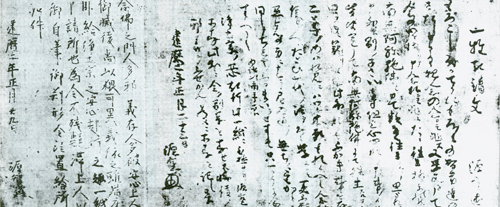Honen’s “One-Page Document”:
In China and Japan, many learned masters have taught that the nembutsu is to meditate deeply on Buddha. But that is not my understanding. Nembutsu is not meditation, nor does it come from study. It is nothing but reciting namu-amida-butsu and believing in our birth in the Pure Land. The Three Minds and Four Modes of Practice are all contained in this. If I am withholding any deeper knowledge than simple recitation of namu-amida-butsu, may I be lost to the compassion of the two buddhas and slip through the embrace of Amida’s original vow.
Those who accept this in faith, though they master all the teachings of Shakyamuni, ought to avoid putting on airs and simply recite namu-amida-butsu alongside illiterate followers of little understanding, no matter whether they be women or men.
I hereby seal this document with the imprint of my hands. The faith and practice of the Pure Land School are fully imparted here. I, Honen, have no teaching but this. To prevent misunderstandings after my death, I make this final testament.

On January 23, 1212, just two days before his death, Honen, the founder of Japanese Pure Land Buddhism, was asked by his disciple Genchi to provide a record of his essential teaching. The result was the Ichimai-kishomon, or “One-Page Document.”
What does it say?
It says to recite the nembutsu and believe in the Pure Land—that is all. That is why in Japan it has been called “easy practice.” “Easy” because, unlike “hard practices” such as Zen, it can be done without prior study. Easy because it can be performed by anyone, anywhere, at any time. But then, things aren’t always what they seem.
In reality, “hard practice” is easy; “easy practice” is hard.
Think of it this way: It is not so difficult to believe that, with many years of meditation practice, you might eventually become enlightened—if only somewhat. In theory at least, it makes a kind of sense. After all, “You get what you pay for.” Thus, “hard practice” is easy. It is easy because you can believe in it. Easy because you can justify it with the same cause-and-effect logic you apply to the world.
Not so rebirth in the Pure Land, which makes no sense at all from a rational point of view. That is why in theLonger Pure Land Sutra, the Buddha calls it “the most difficult of all difficulties.” How difficult it is to believe that Amida Buddha accepts us into the Pure Land just because we recite his name. How impossible to believe that such a place even exists. The mind reels at the thought of it. Koans we can understand, sort of. And meditation makes sense. But this?
In the face of such an assertion, it becomes clear why, in the end, Honen advised his disciples to seek out the company of the illiterate followers of simple faith, then sealed the document with his handprints and declared that the teaching was completely imparted therein. Among all things deep and inscrutable, the faith of the simple is the deepest and most inscrutable of all. ▼
Thank you for subscribing to Tricycle! As a nonprofit, we depend on readers like you to keep Buddhist teachings and practices widely available.